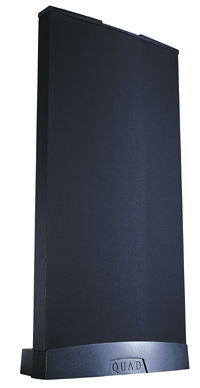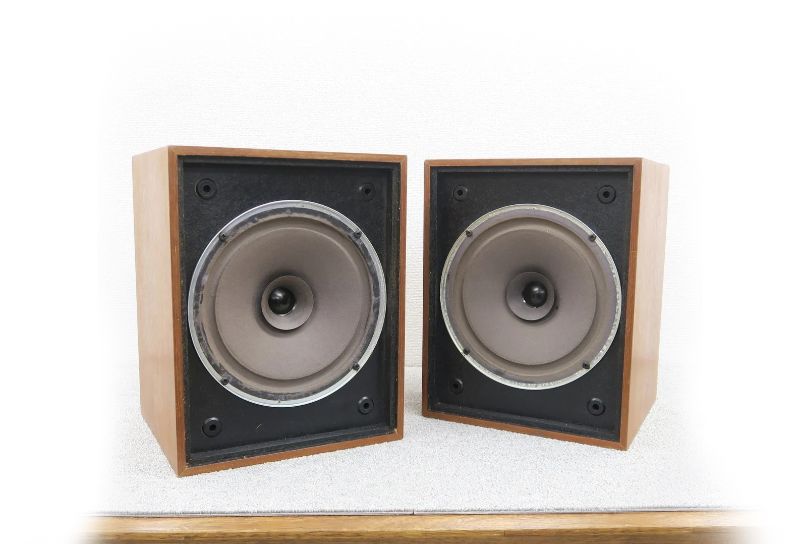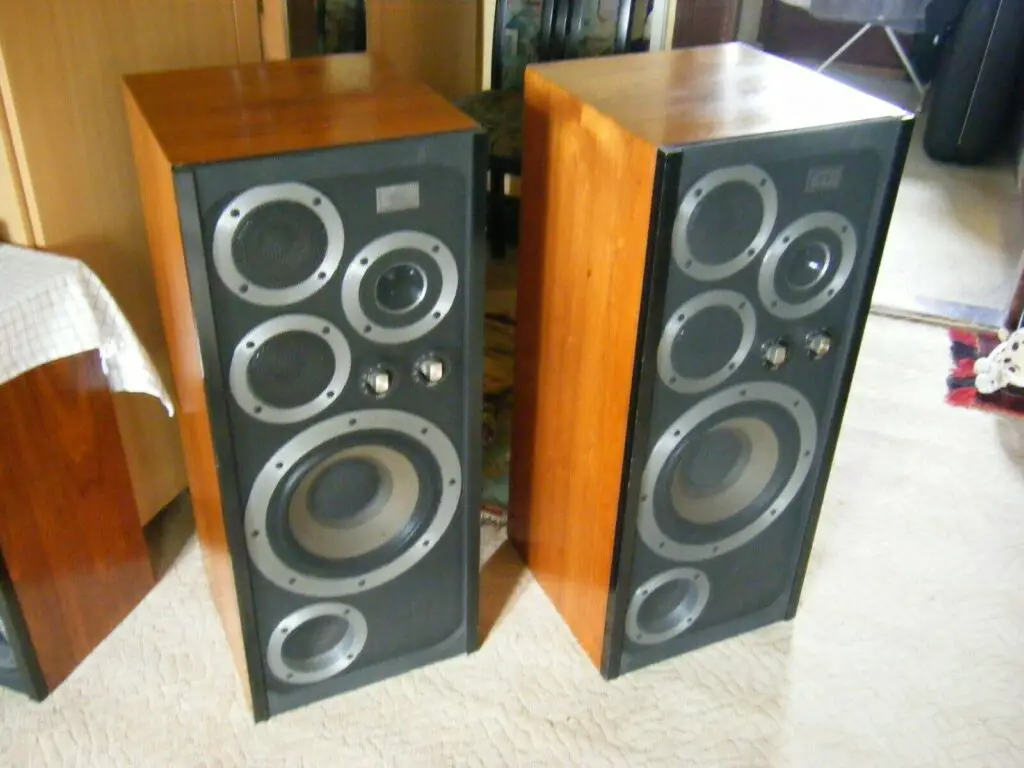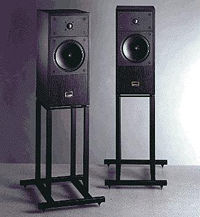Peter Walker of Quad was entirely correct in looking for a better way to construct a loudspeaker. The failures of his flagship loudspeaker, the Quad CR Corner Ribbon, which was a radical hybrid design with a ribbon tweeter and a conventional bass driver in a wood cabinet, inspired him. Even though it was one of the most advanced products of its day, it fell short of Walker’s expectations. Years of development, combined with tremendous creativity and intelligence, resulted in the introduction of the ESL-57 electrostatic in 1957. It was a watershed moment, and tradition has it that several rival loudspeaker manufacturers left the inaugural Quad electrostatic demonstration with their heads in their hands…
The new ESL-57 uses brilliant new push-pull electrostatic panels to cover bass, mid, and treble in a seamless manner, whereas the Corner Ribbon employed a ribbon tweeter and moving coil bass driver. Walker achieved something incredible in the grand scheme of hi-fi things with the help of mathematician Peter Baxendall: full-range sound without the cabinet colorations or drive unit difficulties that plague conventional speakers. There was practically nothing else like it — the Quad Electrostatic sounded clean, detailed, open, and smooth like no other of its day, using plastic film in its drive units, vibrating between two charged plates to produce sound waves.
Quad, therefore, had a difficult time replacing it, and the speaker remained on the market for nearly two and a half decades. Finally, in 1981, the ESL-63 was released, with the number 63 indicating the year in which development began. It was a huge step forward from the 1957 Quad electrostatic, as it was the first Quad electrostatic intended for the stereo age. The prior model was built from the beginning to be a mono product, firing into a room from a single point and filling it with sound. The ’63, on the other hand, was a complete stereo design from the ground up, and it was utilized differently, in pairs in a listening room. Walker spent a lot of time trying to figure out how to improve the dispersion characteristics of the device, and came up with revised panels with two sets of concentric annular electrodes fed through successive delay lines.
“That was a radical rethink,” Comeau adds. “He went back to the foundations to develop a true point source.” “Peter Walker had a lot of ideas, and he even considered installing a loudspeaker in a wall at one point, but he realized that it wouldn’t work in most people’s homes!” So, as he often did, he returned to mathematics and considered the concept of a delay line – a loudspeaker in which the elements of the signal gradually get increasingly delayed as the frequency range is increased, resulting in a spherical waveform generated from the loudspeaker, a real point source. This gave him the annular rings seen on the ESL-63 and all of its descendants’ panels. You’ve got a pair of panels in the middle that couple together to form annular rings, with high frequencies in the middle gradually spreading out to midrange, and then the two bass panels top and bottom on the outside. The panel manufacturing procedure was also much more sturdy; it was a significant improvement.”
The ESL-63 was a wonderful loudspeaker in its day, and a significant upgrade over the ’57 in a lot of areas — yet debates about which is superior continue to rage even today. Both have been chastised for their lack of deep bass and inability to drive big listening spaces to high volumes. Stacking ESL-57 speakers on top of one another was popular during the ESL-57 era, effectively driving four speakers as two. This design was devised for Quad’s replacement for the ’63 because it generated excellent results. The ESL-988 was a modest improvement and update of the ESL-63 when it was released in 2,000 units, but Quad also offered the ESL-989, which was a far larger electrostatic loudspeaker that promised the magic of those early stacked ESL-57s but in one piece. The extra pair of bass panels on the ‘989 didn’t just improve bass performance because of the greater panel surface – the significant height increase also had an effect, acting as a force multiplier…
“In the bass, the taller speaker is getting closer to being a line source,” Peter Comeau explains. “This, combined with the fact that the speaker is a point source in the midband, makes for an intriguing mix.” People stacked ’57s in the false idea that they were boosting panel area and sensitivity, when in fact they were doing far more. The sum of the parts was far more than they had hoped for, and they ended up with something that resembled a line source in the room. When it comes to professional audio, a line source – usually a series of parallel combinations of bass/midrange drivers that add up to an acoustic source bigger than the sum of its parts – is used to drive power across a long distance. Things are different in a room because you don’t have a large open space to fill, so you’re attempting to power the space. The beautiful thing about a line source is that once you get a sufficient distance away from it, it doesn’t obey the inverse square law of power vs distance. With a point source, power reduces dramatically with distance, but with a line source, it keeps the same, which can be advantageous, especially in terms of bass response.”
Quad’s ESL-988/989 was the company’s first attempt to make an electrostatic speaker utilizing current technology. The smaller ‘988 was just a modernized ESL-63, while the bigger ‘989 was a reworking of the ‘stacked Quad’ concept, now owned by International Audio Group. The ‘988 received a much-needed, more sturdy housing, as well as better electronic components. The delay lines’ wiring was updated, and the copper concentration in the electrodes was raised. The speaker was slightly slanted backwards at the same time. All of the aforementioned changes were included in the £4,000 ESL-989, which had fifty percent more radiating area and was 40cm taller than the old ’63 thanks to its new panels. It weights roughly 25kg, which is partly due to the fact that its 1,335x670x315mm cabinet has lots of air inside. Bass is supposed to go down to 30Hz (-6dB), compared to 35Hz on the ‘988, with superior power management. The sensitivity is reported to be 86dB/1w/1m, and the nominal impedance is 8 ohms. The recommended amplifier power ranges from 50 to 150 watts, while at least 100 watts is ideal.
The Quad ESL-989, when properly placed, sounds like nothing else. It has an evenness and coherence of sound that few other loudspeakers at any price can match, and it can drive the listening room in a way that most traditional speakers – at any price – can’t match. But don’t expect pyrotechnics; this isn’t a spectacular or showy sound. There’s no false bass peak at 90Hz, and the treble isn’t zingy and tinselly either. Despite this wonderful loudspeaker’s many fine characteristics, some will discover that their particular musical favorites seem a little lacking…
The impartiality and balance of the ‘989, as well as its speed, are ideal for classical music. Transients have very little overhang, so everything sounds well-defined and spacious. There’s a lot of low-level detail, and it handles the harmonics of brass instruments with great sensitivity; massed strings are also a joy to listen to with orchestral music. Then there’s the outstanding stereo imagery and soundstaging; the ‘989 transports you to a spacious space filled with music. Instruments are inserted within with laser-like precision. This large electrostatic works well with electronic music, sounding amazingly clean and accurate throughout the room, with exceptional sound dispersion and rhythmic capabilities because to the panels’ ability to stop and start so quickly.
However, some people may perceive rock music to be less visceral than they prefer, as the treble lacks sparkle and the bass lacks wallop. Electrostatic bass is wonderful; it’s like an LED that turns on and off, but it lacks the tactile heaviness that some rockers seek. The ESL-989’s cabinet is simply not solid enough to communicate the full dynamic impact of tightly recorded rock music, and this is where the ESL-989 begins to exhibit its own structural weakness. It’s easy to see why the ESL-2905, which came out five years later, had a much improved frame and rear bracing bar. The ESL-989 isn’t flawless, but no loudspeaker is – and it does several things far better than its current price rivals.
The ESL-989, like all of its electrostatic ancestors, is a dipole, which means it emits as much sound from behind as it does from in front. This means that speaker placement is crucial; each speaker should be set back from the boundary wall, but can stand close to the side wall for more room reinforcement if necessary. The ‘989 is a floorstander, meaning it makes advantage of the ground to create bass extension. “However,” Peter Comeau points out, “the taller electrostatics are closer to the ceiling and you start to put this into play, producing significantly more bass power and extension than the panel size should have.” People wouldn’t need to bother around with subwoofers if they just paid attention to properly placing the huge ESLs in a room – since they’ll go down to 30Hz with no trouble…” When properly positioned, the new ESL-989 was the first manufacturing Quad electrostatic to achieve this feat, bringing all of the benefits of electrostatic operation as well as a deep, powerful bass that gave very little to a box loudspeaker.
The Quad ESL-989 was a remarkable huge loudspeaker that was one of the great audiophile bargains of its day — when properly placed, it could easily outperform many moving coil speakers costing many times as much. It’s a great secondhand deal these days – especially if you like classical music – and prices start at £2,000. You will be amazed if you choose a pair in good condition that has been serviced lately.







